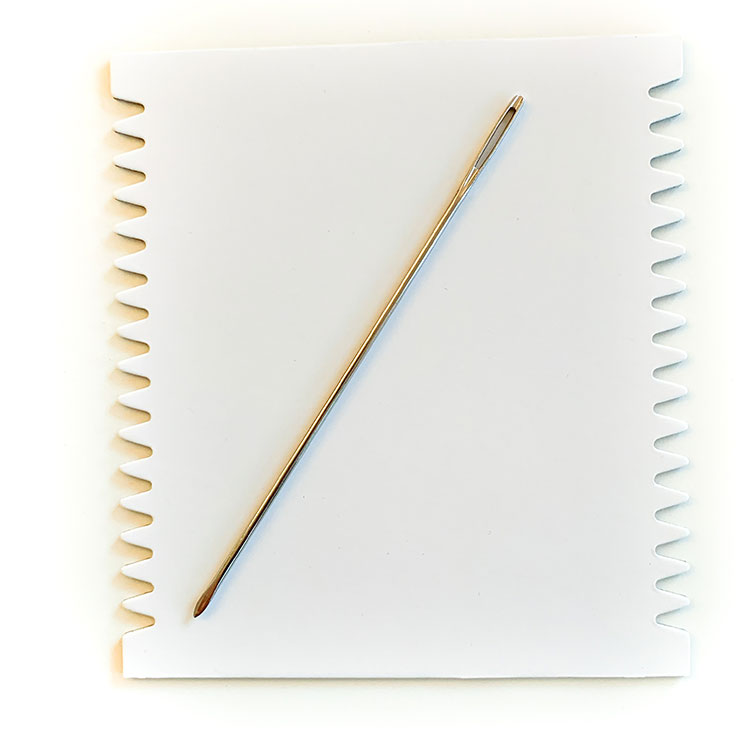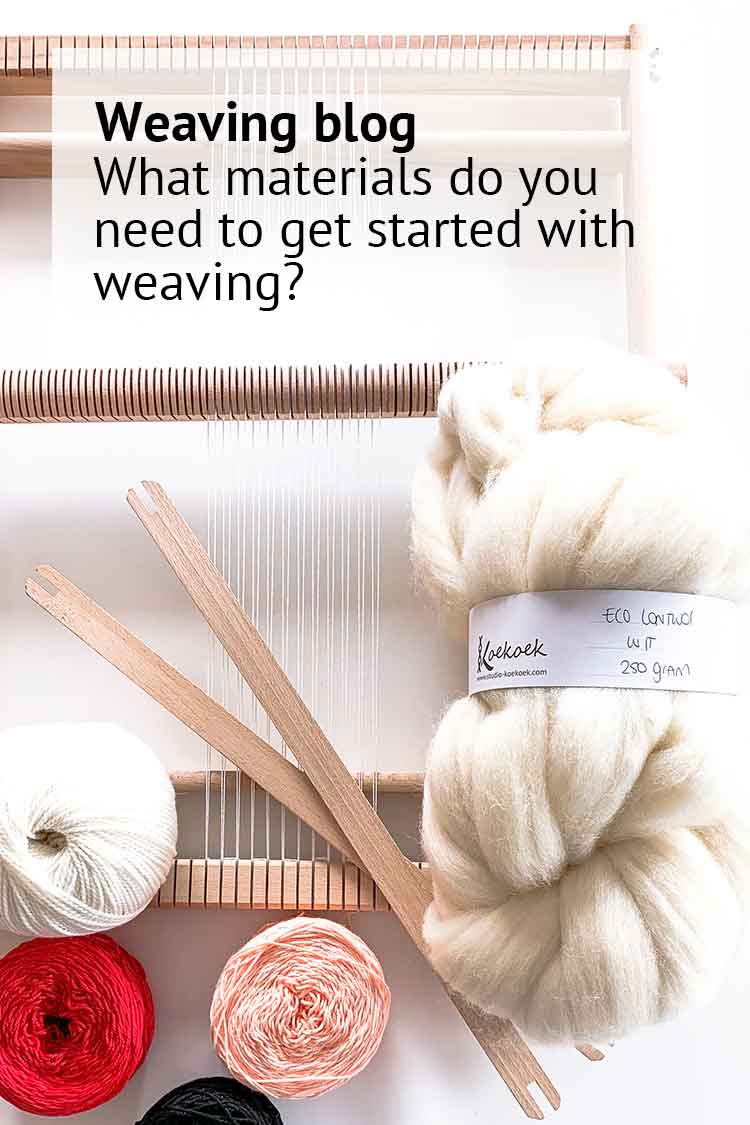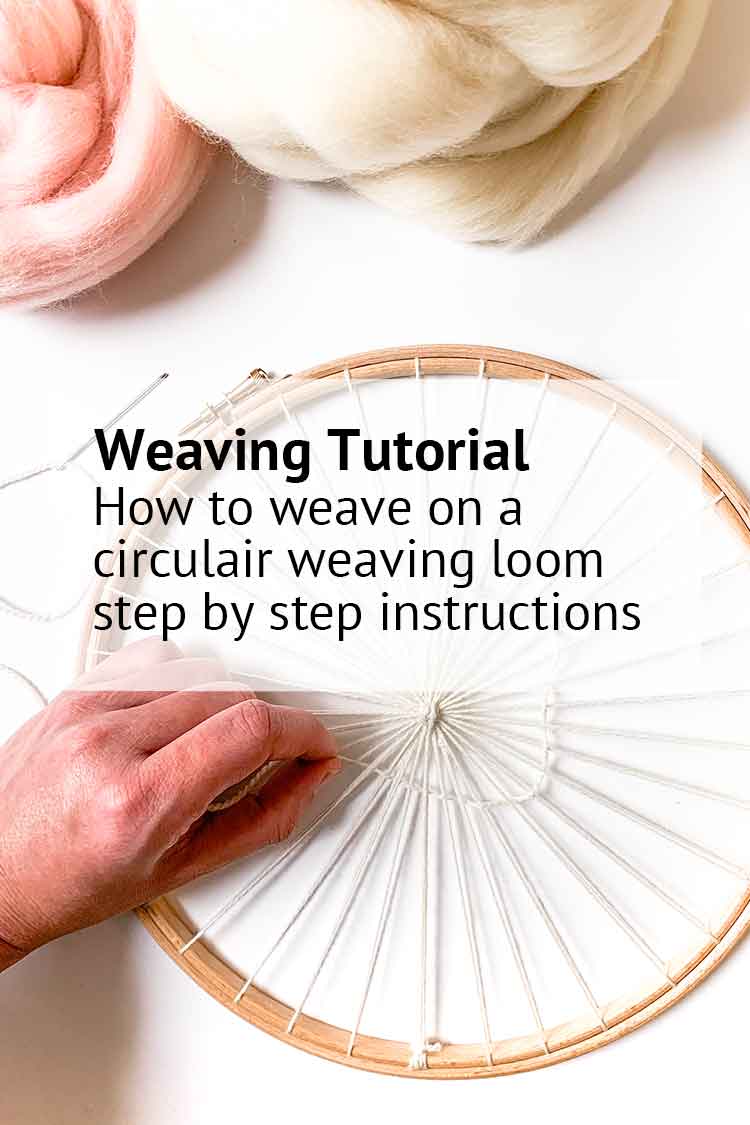Weaving terminology glossary
When you’re new to weaving, you may like an explanation of terms used in weaving instructions. Like every craft, also weaving has specific language. In this blog we share an extensive list of weaving terminology for weaving on our lap looms as well as those used by weavers that work on bigger and more complex weaving looms.
We’ve sorted the terms alphabetically, but you can also simultaneously press Control+F on your keyboard to find the specific weaving terminology you’re looking for.

Weaving terminolgy A-Z
Advancing the warp
When a pattern tells you to advance the warp, it means that you are asked to release the warp beam and wind some of your woven cloth onto the beam.
Apron
The cord or canvas which is attached to the cloth and warp beams and which is long enough to reach the shafts. The apron has a wooden bar or metal rod for attaching the warp threads.
Beam, back
Beam at the back of the loom over which the warp passes after leaving the warp beam.
Beam, breast
Beam at the front of the loom over which the cloth passes before it winds onto the cloth beam.
Beam, cloth
Beam in the front of the loom which rotates and holds the woven cloth.
Beam, foot
Beam below the breast beam for resting the feet.
Beam, knee
Beam above the cloth beam over which the cloth passes before it winds onto the cloth beam. It allows space for the weaver’s knees.
Beam, sectional
A warp beam divided into sections for warping very long warps. Other equipment is necessary to make sectional warps.
Beam, warp
Beam at the back of the loom which rotates and holds the warp.
Beaming
Winding a prepared warp onto the warp beam.
Beaming sticks
Sticks which are placed onto the warp beam as the warp is wound on.
Beater / Batten
Swinging frame holding the removable reed, used to beat the weft in place. With a lap loom a beater can also refer to a weaving comb used to beat down the weft threads.
Back to front warping
A phrase used to describe the traditional warping method. Currently the front to back warping is more populair.
Beating
After every row that you weave, you want to push the weft threads down. This is called beating. Beating helps to create an even tension and to get a symmetric design. You can use your fingers or a fork. We prefer to use a weaving comb.
Balanced weaving / Evenweave
When you create a balanced weaving or evenweave fabric you weave a fabric with the same number of threads in the weft and warp.
Block
In weaving terminology, a block stands for a group of 2 or more threads which form a unit in a weave.
Bobbin
A bobbin is a spool or cylindrical barrel that can be used to wound your yarn around. This makes it easier to move the yarn through the warp threads, similar to a shuttle.
Bobbin winder
A tool for winding bobbins or spools either by hand or electric power.
Boat shuttle
A shuttle which looks like a boat and is hollowed out to hold a bobbin or quill of weft thread.
Brake
A device to hold a warp beam from turning, made of a metal cable or band which winds on a metal drum.
Warp Beaming
The process of winding your warp thread onto the warp beam, making it spaced out to its weaving width.
Bout
One wound group of warp threads, tied together, which contains up to 6″ of warp width.
Bubbling
When bubbling, you allow some looseness in the weft to provide the extra length needed for the weft to be beaten in without causing draw-in.
Choke ties
Very tight, temporary ties spaced every two yards along the warp bout to keep the threads secure. Only used in large weaving projects.
Cloth diagram
A diagram that shows the pattern that you will weave when making the cloth.
Counterbalance loom
A loom with a pulley system with horses or dowels to attach the shafts. When a shed is made, some shafts rise and some sink.
Countermarch loom
A loom with jacks at the top of the loom with cords attaching them to the shafts and two sets of lamms. When a shed is made, some shafts rise and some sink.
Cord
A single strand made of twisted multiple threads, yarns or strings.
Dent
The holes in a rigid-heddle that the warp threads should pass through are referred to as dents. Sometimes rigid-heddle looms can be labeled by the number of dents they have. For example, a “16-dent rigid-heddle” contains 16 dents per inch.
Draft pattern
The draft is a diagram representing the threading, tie-up and treadling for a weave.
Drawloom
A two-harness loom. The first harness usually has 4 – 10 shafts and the second creates a pattern by using a set of shafts or individually tied groups of thread.
Draw-in
The narrowing of the weaving at the selvages due to the natural shrinking of the web. Excessive draw-in is caused from the weft being too tight.
Drawdown
The drawdown is the part of the draft which shows the cloth diagram above or below the threading.
EPI
EPI is weaving terminology for ends per inch: the number of warp threads per inch.
Fabric protector
A protective board that is attached to the breast beam.
Fell
The edge of the weaving where the last weft has been beaten in.
Fiber
Fibers are loose bits of materials that are not twisted. Fiber is used to make yarn.
Filling
This term is used in the textile weaving industry for the horizontal threads in a fabric (the weft).
Finishing
The final threadsments of the woven piece such as washing, fulling or pressing.
Fly shuttle
A shuttle used for weaving on wide looms which is supported by a shuttle race and moves across the loom by pulling a cord.
Guide string
A non-stretchy cord measured to be the same length as the warp and placed on the warping reel or frame to be a guide for winding the warp bouts.
Scroll down and learn more weaving terminology

Heading
The first weaving rows used to create an even spread of the warp threads while weaving. It is often used when making rugs, placemets and tapestry’s to strenghten the edge. You can remove the heading when taking the finished weaving project from your loom.
Heddle bar
Our weaving looms include a heddle bar. This is the component you can find in the middle of your weaving loom that is used to shed the warp threads more easily. Each warp thread will need to go through a separate slot in the heddle bar before you start weaving.
Heddle eye
The opening in a heddle for threading a warp end.
Inlay / Laid-in / Brocading
Inlay is when designs are created on top of a plain woven fabric by use of a second or supplementary weft. Discontinuous inlay is when the supplemental weft is used in certain areas only, and continuous inlay is when the supplemental weft moves across the cloth from selvage to selvage (pick-up weaves).
Jack loom
A loom with jacks below the shafts to push the shafts up, or on top of the loom and attached to pull the shafts up. When a shed is made, some shafts rise and the other shafts remain down by their own weight, as they are not tied to anything which would keep them down.
Lap loom
A lap loom is typically a smaller sized loom that can be used on your lap while seated.
Lamms
Horizontal wooden lever sticks which attach the treadles to the shafts.
Lease sticks
Flat, thin, smooth, wooden sticks which are inserted into the cross (or lease) in the warp to keep the correct order of threads.
Levers
Wooden or metal handles on table looms used for making a shed.
Loom
A loom is a supporting structure that is used to weave on. It will hold the warp threads for you while you are weaving. If the weave is finished, it can be removed from the loom and support itself without falling apart.
There are many different types of looms. The most common is the frame loom, which has a rectangular shape and is often made out of wood. It’s popularity mainly comes from the fact that it is the most affordable model and best to learn the basics of loom weaving. Other models you might come across are the rigid-heddle loom, lap loom, and inkle loom
Packing needle
A long metal needle with a bended tip and big eye. The bended tip helps to guide your yarn through the warp threads.
Pawl
A catch device attached to the loom frame which falls to catch into a ratchet tooth to keep the ratchet from rotating.
Pattern Weave
This weave requires two shuttles, two wefts, and often different colors or threads. The pattern is usually threaded or treadled differently from plain weave.
Plain Weave
This is the simplest weaving technique for beginners. To create this pattern, the weft thread needs to alternatively go over and under the warp thread without skipping any threads.
Sometimes the plain weave is also referred to as linen or tabby weave. It creates a sturdy and long-lasting fabric.
PPI
PPI is the weaving terminology for the picks per inch: the number of wefts per inch.
Ply
Ply is a unit of measure, the count of individual threads, strings used in making a string, yarn, thread, cord or rope. To ply is the act of twisting yarns, thread, cord or rope to make a large strand.
Profile draft
A short draft where one square represents two or more threads, usually one unit or one block.
Quill
A paper or cardboard tube on which weft threads are wound for use in a boat shuttle.
Raddle
A long, flat, narrow piece of wood with nails or metal pins every 1/4″ or 2”, used to spread the warp evenly for beaming the warp onto the warp beam.
Ratchet
A toothed wheel placed at the end of cloth and warp beams which is held by a pawl to keep the beam from rotating.
Reed
The reed is a piece of equipment used in a shaft loom. It looks similar to a rigid-heddle without any holes. It is used to keep a steady width between the warp threads and for beating the weft. But due to the absence of dents, it can’t shed the warp threads. Sometimes the words “reed” and “rigid-heddle” are used interchangeably because the serve some similar functions.
Rigid-Heddle Loom
This is a type of loom that uses a rigid-heddle to make the shed. The rigid-heddle can be used to spread the warp threads evenly and beat the weft as well.
Rising shed
A description of a shed on a loom where the shafts rise.
Rope
A single strand made from multiple cords.
Selvage
The woven edge of a fabric is called selvage. A selvage is also called the “self-finished” edge of a piece of fabric which keeps it from unraveling and fraying. The term “self-finished” means that the edge does not require additional finishing work, such as hem or bias tape, to prevent fraying. On your weaving loom your selvage are the right and left ends of your weaving project.
Selvage loops
The extensions of the weft beyond the selvage. You create selvage loops when your weft tension is too loose.
Sett
Weaving terminology for the number of warp threads per inch.
Shaft / Harness
A frame or two sticks with heddles which moves up and down to form sheds.
Shed
The shed is the opening created on the loom where the weft passes. It is the seperation between the upper and lower warp (vertical) threads. While weaving, the warp threads are alternatingly separated in two different sets; the upper set and the lower set. If you separate these two sets you can pass the weft thread through the warp in one go using a shuttle. This speeds up the process and makes weaving much easier.
If you use one of our looms the heddle bar can be used to create a shed.
Shot / Pick
The shot is a single pass of weft through the shed.
Shuttle
The weaving shuttle is a tool, typically wooden, used to hold the weft thread while weaving. A shuttle can come in different shapes. We include shuttle sticks with our weaving looms. You may also find boat shuttles, ski shuttles, inkle shuttles and band loom shuttles in your local craft shop.
Shuttle race
A horizontal beam in front of the reed, attached to the beater on which the fly shuttle glides. Jack looms also have shuttle races to support the shuttle, as the warp tension is looser than on other looms.
Ski shuttle
A shuttle with upturned ends which is used for rug weaving.
Sleying
Passing the warp ends through the dents in the reed.
Sleying hook
A small flat tool with a hook used to pull the warp ends through the reed.
Stick shuttle / Flat shuttle
A smooth flat stick to wind weft threads for weaving.
String
A single strand made of multiple twisted threads.
Swift
An adjustable frame for holding a skein of yarn.
Take-up
The amount that the warp shortens in length due to the undulation caused by the weaving.
Temple stretcher
Adjustable wooden or metal bar with sharp points placed on the woven web to keep the width constant and the sett the same across the web.
Twill Weave
The twill weave creates distinct diagonal lines through the weave. To create this effect, the weft thread needs to go over two warp thread and then under two warp threads. On the next row, you then offset the pattern by one thread to create the diagonal lines.
The twill weave is also used to make Denim, so when you take a close look at your jeans you’ll get an idea of how it looks like.
Threading / drawing in
Drawing the warp threads through the eyes of the heddles.
Threading draft
Instructions for threading heddles on a loom.
Threading hook
A small tool with a thin narrow hook used to pull the warp ends through the heddle eyes.
Treadles
Foot petals used to move the shafts to make a shed.
Thrums
Unwoven warp left when the last woven piece is cut from the loom. It is called loom waste when planning warps.
Tie-up
The tying or connecting of cords to parts of the loom to hang the shafts, lamms and/or treadles. Tie-up also refer to instructions for tying up treadles on a loom, indicating which shafts rise and which sink.
Treadling draft
Instructions for treadling a weave structure.
Warp end
Each individual warp thread in a fabric is called a warp end or end.
Warping board
A frame with wooden pegs for measuring short warps.
Warping reel
Large adjustable revolving frame for winding warps.
Warp thread
The warp thread is the thread that is strung over the loom vertically. This thread holds the tension while you weave and it is the backbone of your weave. It is important that this thread is very strong.
Warp and weft is probably weaving terminology you’ll learn with your first project ;-).
Weaving needle
Typically a long needle with a big eye which you can for a weaving your weft yarn into the warp thread.
Weaver’s Knot
The weaver’s knot is the smallest knot that you can make to connect two threads together. This is our preferred way to repair broken warp ends or to connect two weft threads when you run out of thread or want to change color. This knot is relatively flat, so it requires minimal attention.
Weft thread
The weft thread is the horizontal thread in your weaving project. You weave this between and over your warp threads. It creates the pattern of your weaving project.
Tabby
A different word to say plain weave. The easiest weaving technique in which you go up and down through your warp threads. A tabby can also be used as ground weave for a pattern weave.
Thread
A thin yarn.
Tromp as writ (as drawn in)
Treadle the weave the same way the threading is written.
Yarn
A twisted thread made from fiber.

When subscribing you allow us to send e-mails to you. You can unsubscribe at any moment you like. Read our privacy policy here







